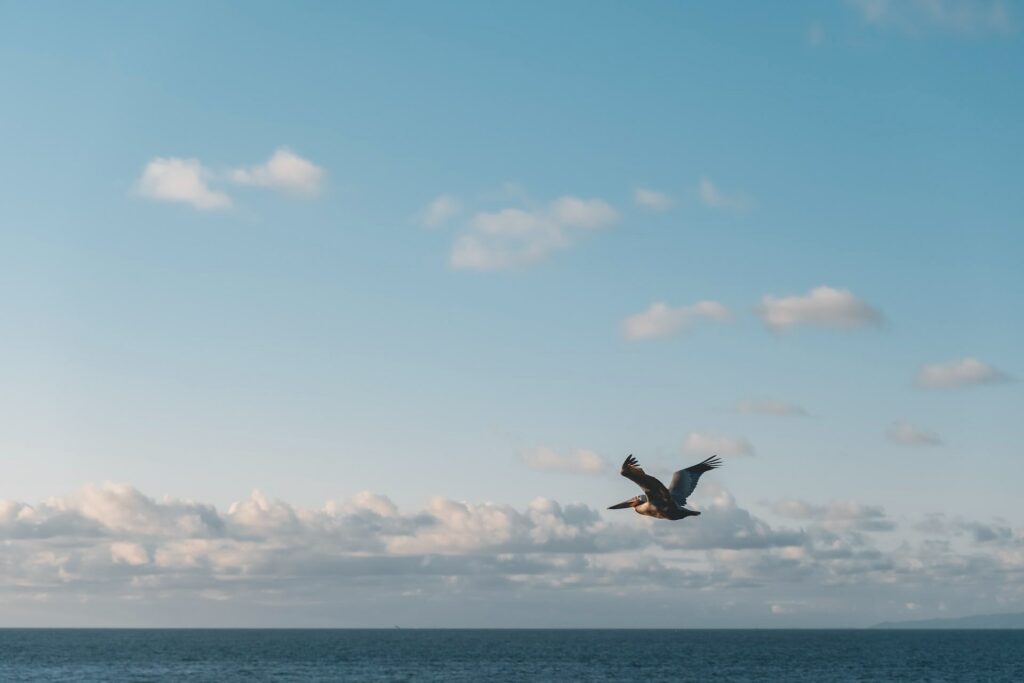In evidenza in questo post
San Diego, California
Avventura di osservazione delle balene e dei delfini a San Diego
Per saperne di più
Continuare a esplorare
San Diego, California
Essenziale a San Diego
Per saperne di più
You can see some amazing seabirds on our City Cruises Whale Watch cruise in San Diego, the most common of which can be found here. Here are some other, less common seabirds, including several species of herons, that can be found in San Diego Bay.
Reddish egret (Egretta rufescens)
The reddish egret is a fairly large heron with a gray body, a reddish neck, and bluish-black gray legs. Its bill is mostly pink and tipped with black. This active egret searches for food in shallow, saltwater habitats and often runs and hops to catch fish with its wings spread out. San Diego is near the northern part of the range for this species on the Pacific Coast.
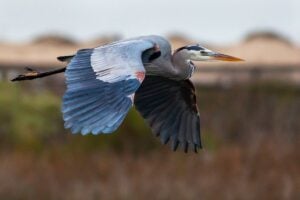
Airone azzurro (Egretta caerulea)
L'airone azzurro è un piccolo airone con il corpo grigio-blu scuro e la testa e il collo di colore da viola a rosso scuro. I giovani sono per lo più bianchi con piume alari grigio chiaro. Quando caccia pesci e rane in habitat poco profondi d'acqua dolce o salata, l'airone azzurro resta fermo nell'acqua bassa e aspetta che la potenziale preda nuoti nelle vicinanze.
Airone tricolore (Egretta tricolor)
Questo airone di medie dimensioni è per lo più grigio scuro, con il ventre bianco e piume rossastre sul collo e sul dorso. Il giovane ha una linea bianca che corre lungo la gola. Quando si nutre, sta in piedi e aspetta che i pesci nuotino, oppure cammina per smuovere il fondo con un piede per attirare le prede.
Green heron (Butorides virescens)
This small, beautifully-colored heron typically rests in a crouched position at the water’s edge often hidden within vegetation. It has a greenish back with a chestnut neck, face, and chest, white streaks on each cheek and throat, dark gray wings, a gray and yellow bill, and yellow legs. The green heron usually sits at the water’s edge and waits for fish and frogs to move by, then spears them with its dagger-like bill.
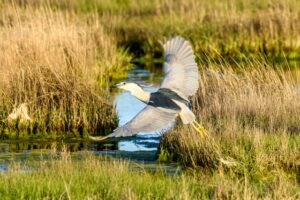
Black-crowned night heron (Nycticorax nycticorax)
The black-crowned night heron is fairly stocky with relatively short yellow legs. The plumage is dark gray from the top of its head to the back, with light-gray wing feathers, and white from the face to the belly. It also has a white patch extending from the base of the upper bill to above the red eyes. Juveniles are mottled brown and white. As its name implies, the black-crowned night heron feeds from dusk until dawn, searching for insects, worms, fishes, amphibians, and other small land and aquatic animals.
Brandt’s cormorant (Phalacrocorax penicillatus)
The Brandt’s cormorant is an iridescent black seabird found in saltwater habitats along the Pacific Coast of North America. Adults have a pale patch at the base of the throat, a bright blue throat pouch, and fine, white plume feathers on their head, neck, and back during the nesting season. During the non-breeding season, adults are much duller in color while juveniles are also a much duller brownish-black. Cormorants swim at the surface and then dive to catch fish or squid, using their webbed feet to actively swim after prey. Like other cormorants, the Brandt’s cormorant holds its wings out to dry after diving.
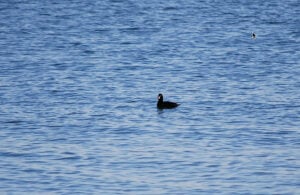
Surf scoter (Melanitta perspicillata)
This sea duck is strikingly patterned in black-and-white. The male is all black with a white forehead patch and a white patch on the back of his neck, and a white, orange, and black patterned bill. The female is a lighter brownish-black with white patches on each side of the head and at the base of the mostly dark gray bill. Nesting takes place during summer in freshwater lakes in high-elevation forests and the tundra mainly in Alaska and Canada. Surf scoters can be found in winter along both coasts of North America where it can often be seen diving for mollusks, crustaceans, and other aquatic invertebrates.
Pacific brant (Branta bernicla)
This small sea goose has a black head, neck, and chest with a broken white “collar” in the upper neck region, a brownish back, a black to light gray belly, and a white rump. The Brant nests in the Arctic on the tundra and spends winters feeding on eelgrass, sea lettuce, and other aquatic plants along both coasts of North America. The Pacific subspecies of brant winters from British Columbia to Baja California, Mexico, and can often be seen swimming and feeding in flocks during the late fall to early spring months in San Diego Bay.
Western grebe (Aechmophorus occidentalis)
The western grebe is a black and white grebe with a long neck, a spear-like yellow bill, and red eyes. This species has a black back with black extending along the back of its neck and a black cap that extends below the eyes. The almost identical Clark’s grebe can be distinguished from the western grebe by its white face (its black cap does not extend below the eyes). Western grebes nest on freshwater lakes and marshes and overwinter in bays, estuaries, and sheltered coasts. They dive to catch fish and occasionally crustaceans and aquatic worms. In the summer nesting grounds, adults perform an elaborate courtship display by rushing across the water with their necks extended.
Pied-billed grebe (Podilymbus podiceps)
The pied-billed grebe is a small, stocky, brown, bird with a short wedge-shaped bill, a brown body, and an extremely short tail. Their bill is marked with a vertical black stripe in the summer giving rise to their common name. Pied-billed grebes dive to hunt small fishes, crustaceans, insects, amphibians, and other small aquatic animals in freshwater lakes, rivers, marshes, and saltwater estuaries and bays.
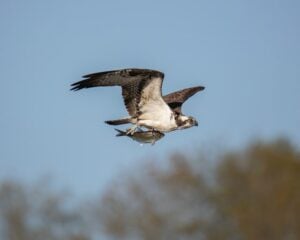
Osprey (Pandion haliaetus)
The Osprey is a common fish-eating hawk spotted in freshwater and saltwater habitats worldwide except in Antarctica. These attractive birds of prey are black to brown and white and have hooked bills and yellow eyes. They have a reversible outer toe on each foot and barbed pads on the soles that let them catch and easily grasp slippery fish. Osprey pairs build huge nests of sticks and other vegetation that are added to each nesting season and used from year to year. Often these nests are built on sea stacks, dried tree snags, and even man-made structures such as light towers, utility poles, and artificial platforms. Some of these nests are decades old and can be 10 to 13 feet tall and 3 to 6 feet across.
Pellicano marrone(Pelecanus occidentalis)
Il pellicano bruno è il più grande dei pellicani nordamericani. Questi grandi uccelli hanno un caratteristico aspetto gobbo, un lungo collo e un grande becco con una sacca per la gola usata per raccogliere i pesci. I pellicani sono per lo più di colore marrone scuro, con alcune sfumature grigio-marrone sulle ali e sul collo. Si trovano nelle zone costiere di gran parte del Nord America, dove si nutrono quasi esclusivamente di piccoli pesci che catturano tuffandosi dall'aria nell'acqua. La riproduzione avviene lungo le coste dalla Virginia al Texas e alla California e nell'entroterra dei Grandi Laghi.
Pellicano bianco americano(Pelecanus erythrorhynchos)
The American white pelican is one of the largest North American birds, with a wingspan reaching almost 10 feet. They are all white with black wingtips and have a long bill with a large throat pouch used for scooping up fish. Pelicans feed cooperatively, swimming in groups to herd and trap small fishes in shallow water where they can be easily caught. These big birds breed along inland lakes in western Canada and the northern United States and spend winters along coasts from California to Texas.
Cormorano pelagico(Phalacrocorax pelagicus)
Il cormorano pelagico è una specie di cormorano che si riproduce nelle regioni oceaniche aperte di tutto il mondo. Questo uccello è interamente nero, con un lungo becco adunco e zampe palmate. Il cormorano pelagico è un eccellente nuotatore e può immergersi fino a oltre 150 metri di profondità alla ricerca di pesci. Questi uccelli nidificano in genere sulle pareti rocciose o sugli alberi in prossimità di specchi d'acqua. Il cormorano pelagico è una creatura sociale e spesso forma grandi colonie con altri uccelli. Tuttavia, questa specie non è priva di predatori: gabbiani, aquile e altri rapaci prendono spesso di mira i cormorani pelagici.

Cormorano a due creste(Phalacrocorax auritus)
Il cormorano a due creste è un grande uccello acquatico dal collo lungo e dal becco adunco. Si trova in habitat d'acqua dolce e salata in gran parte del Nord America. Il cormorano a due creste è un eccellente nuotatore e tuffatore e si nutre di pesci, gamberi e altri animali acquatici. Il piumaggio scuro dell'uccello lo aiuta a mimetizzarsi dai predatori e le sue zampe palmate lo aiutano a remare rapidamente nell'acqua. Il cormorano a due creste è una specie protetta e il suo numero è aumentato negli ultimi anni. Tuttavia, l'abitudine dell'uccello di nidificare su strutture costruite dall'uomo, come linee elettriche e barche, ha causato alcuni conflitti con l'uomo.
Piccione di roccia(Columba livia)
Il colombaccio è una specie di piccione originaria dell'Europa, dell'Asia e dell'Africa. È anche l'uccello più comune nelle città. Il colombo di roccia è un uccello di medie dimensioni con un corpo grassoccio e zampe corte. Il suo piumaggio è solitamente grigio o blu, ma può essere anche bianco, marrone o nero. Ha una testa piccola con un becco appuntito. I colombi di rocca vivono tipicamente in stormi e sono spesso osservati mentre cercano cibo nelle aree urbane. Sono noti anche per i loro vocalizzi. Il colombaccio è una specie importante sia in natura che in cattività. Viene spesso utilizzato nella ricerca grazie alla sua capacità di adattarsi a diversi ambienti. Il colombo di monte è stato anche introdotto in molte parti del mondo, dove si è affermato come specie fastidiosa.
Conclusione
Se volete vedere alcuni degli uccelli marini meno comuni della baia di San Diego, date un'occhiata al nostro elenco. Anche se qui si possono vedere molte altre specie, pensiamo che queste quindici vi daranno un buon campionario di ciò che c'è in giro. Avete avvistato qualcuno di questi uccelli durante le vostre escursioni nella baia? Fatecelo sapere nei commenti qui sotto!
In evidenza in questo post
San Diego, California
Avventura di osservazione delle balene e dei delfini a San Diego
Per saperne di più
Continuare a esplorare
San Diego, California
Essenziale a San Diego
Per saperne di più


